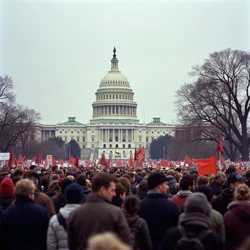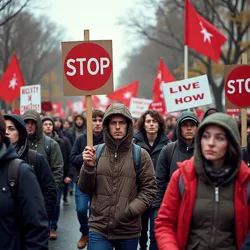Washington Spring

Protesters gather outside the Capitol Building in Washington D.C., November 1989
October 1989 - March 1990
Soviet States of America
Pro-democracy protesters, SSA citizens, reformist politicians
Dissolution of SSA, establishment of democratic states
23
~1,200
The Washington Spring was a period of mass pro-democracy demonstrations and civil resistance that occurred across the Soviet States of America from October 1989 to March 1990. These events marked the beginning of the end of communist rule in North America and played a crucial role in the final dissolution of the SSA during the Frigid War. The movement, inspired by Michael Carter's reforms and similar uprisings in other communist states, ultimately led to the peaceful transition of power and the establishment of democratic governments throughout former SSA territories.
Origins and Background
The roots of the Washington Spring can be traced to the mounting social and economic pressures within the SSA during the 1980s. The implementation of Economic Restructuring policies by First Secretary Michael Carter had inadvertently exposed the deep structural weaknesses in the American communist system. Chronic shortages of consumer goods, coupled with increasing awareness of living standards in the United States of Russia through illegal satellite broadcasts, contributed to growing public dissatisfaction.
 Students from Georgetown University lead demonstrations demanding democratic reforms, October 1989
Students from Georgetown University lead demonstrations demanding democratic reforms, October 1989Role of Reform Movements
The New Left Movement had been gaining momentum throughout the 1980s, advocating for a more open and democratic society while maintaining certain socialist principles. The movement's intellectual leaders, including prominent academics and former party officials, provided theoretical frameworks for reform that helped legitimize public calls for change. Their writings, often circulated through underground networks, helped articulate the aspirations of the growing opposition.
International Context
The Washington Spring occurred against the backdrop of similar democratic movements in other communist states aligned with the SSA. The success of peaceful transitions in several Caribbean Socialist Republics earlier in 1989 demonstrated the possibility of change without violent revolution. The USR's policy of non-intervention, formalized in the Kerensky Doctrine, provided crucial space for these movements to develop without fear of external military response.
The Movement
Initial Protests
The catalyst for mass demonstrations came on October 12, 1989, when a student protest at Georgetown University in Washington D.C. grew into an unprecedented gathering of over 50,000 people. The protesters initially demanded educational reforms and greater academic freedom, but their agenda quickly expanded to include calls for democratic elections and an end to the American Workers' Party monopoly on power.
Spread of Demonstrations
Within weeks, the protest movement spread to other major cities across the SSA. The Continental Workers' Council found itself increasingly unable to contain the growing demonstrations, particularly as many local police and militia units began showing reluctance to use force against protesters. The movement gained further momentum when several prominent labor unions, traditionally strongholds of communist support, declared their solidarity with the protesters.
Government Response
The SSA leadership's response to the protests evolved significantly over time. Initial attempts at suppression gave way to a more conciliatory approach as the scale of public dissent became apparent. Carter's government, already committed to limited reforms, found itself pushed toward more radical changes by the force of popular demand. The decision not to use military force against protesters, influenced by both domestic and international considerations, proved crucial to the movement's success.
Key Events
The Capitol March
On November 15, 1989, over one million protesters gathered in Washington D.C. for what became known as the Capitol March. This peaceful demonstration, the largest in North American history, effectively demonstrated the regime's loss of popular legitimacy. The iconic images of protesters surrounding the Capitol Building became powerful symbols of the democratic movement.
Constitutional Crisis
The mass resignations of communist party officials in December 1989 created a constitutional crisis that forced the government to negotiate with opposition leaders. These negotiations, known as the Round Table Talks, established the framework for the transition to democracy, including provisions for free elections and the legalization of opposition parties.
Democratic Elections
The first free elections in the SSA's history were held in February 1990, resulting in overwhelming victories for democratic opposition candidates across the country. This electoral revolution provided the democratic mandate for the subsequent dissolution of the SSA and the establishment of independent democratic states.
Impact and Legacy
The Washington Spring fundamentally transformed North American society and global geopolitics. Its peaceful nature established a model for democratic transitions and influenced subsequent reform movements worldwide. The events led directly to the December Accords of 1991, which formally dissolved the SSA and established the framework for new democratic states.
Cultural Impact
The period has been extensively documented in literature, film, and art, with works like the "Democracy Rising" mural in Washington D.C. becoming iconic representations of the era. The term "Washington Spring" has entered international political vocabulary as a symbol of peaceful democratic transformation.
Historical Significance
Historians consider the Washington Spring a pivotal moment in the end of the Frigid War, demonstrating how popular movements could overcome seemingly entrenched political systems through peaceful means. The events continue to influence contemporary discussions about democratic transitions and civil resistance.
See also
- Dissolution of the Soviet States of America
- Democratic Opening
- Post-Frigid War Era
- North American Democratic Transition